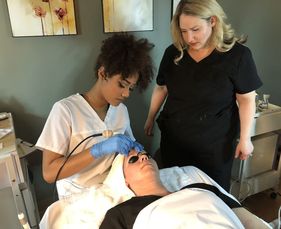Satisfactory Academic Progress Policy
Satisfactory Academic Progress
The Satisfactory Academic Progress policy is applied consistently to all students in a Department of Education and NACCAS-approved program, regardless of payment method, program, and schedule. A complete list of these standards is included in our school catalog ensuring notification of these expectations prior to enrollment in any program.
Minimum Satisfactory Academic Progress Requirements
Minimum satisfactory academic progress shall be determined by a cumulative grade average of theory and practicum grades of no less than 75% and 80% attendance rate. The attendance percentage is determined by dividing the total actual hours completed by the total number of scheduled hours.
Grading Scale
The grading scale for theory examinations shall be as follows with a passing grade of a score of 75%
(C) or above:
Excellent-A: 100-93,
Very good-B: 92-85,
Satisfactory-C: 84-75,
Unsatisfactory-F: 74 or below
All students must maintain a minimum average grade percentage of 75% in order to graduate.
For practical examinations, students can either score “Proficient” or “Developmental Opportunity.”
The Satisfactory Academic Progress policy is applied consistently to all students in a Department of Education and NACCAS-approved program, regardless of payment method, program, and schedule. A complete list of these standards is included in our school catalog ensuring notification of these expectations prior to enrollment in any program.
Minimum Satisfactory Academic Progress Requirements
Minimum satisfactory academic progress shall be determined by a cumulative grade average of theory and practicum grades of no less than 75% and 80% attendance rate. The attendance percentage is determined by dividing the total actual hours completed by the total number of scheduled hours.
Grading Scale
The grading scale for theory examinations shall be as follows with a passing grade of a score of 75%
(C) or above:
Excellent-A: 100-93,
Very good-B: 92-85,
Satisfactory-C: 84-75,
Unsatisfactory-F: 74 or below
All students must maintain a minimum average grade percentage of 75% in order to graduate.
For practical examinations, students can either score “Proficient” or “Developmental Opportunity.”
|
Academic and Attendance Progress Evaluations
The Chrysm Institute of Esthetics monitors student grades and attendance to ensure satisfactory progress is being made. Academic progress is evaluated based on attendance (quantitative) and academic performance (qualitative) elements at designated evaluation periods. Academic performance is evaluated via a reasonable system of grades measured against a standard grade scale. Students are assigned academic learning and a minimum number of practical experiences. Academic learning is evaluated at the end of each unit of study. Practical assignments are evaluated as completed and counted toward course completion when completed safely and sanitarily. If the performance does not meet safety and sanitation requirements, it is not counted and the performance must be repeated. |
|
The evaluation will occur no later than the midpoint of any program. Student’s academic progress is evaluated at 300 scheduled clock hours. At the end of the evaluation period, the school will determine if the student has maintained at least a 75% grade average and at least 80% cumulative attendance. Should the student continue to meet cumulative minimum attendance and grade requirements, graduation will occur within the maximum time frame allowed. Evaluations will include a review of theory test grades, missing exams or assignments as well as practical skill development.
|
In the event of absence, please see Attendance Protocol and Procedures
Determination of Progress Status
Students who meet the minimum requirements for attendance and academic performance are considered to be making satisfactory academic progress. A digital copy of their satisfactory academic progress evaluation results will be made available to the student at the time of the evaluation and students will be notified of any evaluation that impacts eligibility for financial aid, if applicable. Students who do not achieve minimum standards are no longer eligible for Title IV funds, unless the student is on warning.
Warning
Students who fail to meet minimum requirements for attendance and/or academic progress are placed on warning and considered to be making satisfactory progress during the warning period. The institution will notify students of any evaluation in which the student is not meeting Satisfactory Academic progress. Title IV financial aid is unaffected by the SAP warning status since the student is considered to be making satisfactory progress during the warning period. However, if placed on warning, the student will graduate in warning status as the academic progress warning period extends to the end of the program since there is only one satisfactory progress evaluation at 300 scheduled hours.
Re-Establishment of Satisfactory Academic Progress and/or Financial Aid Eligibility
Students are considered to be making satisfactory academic progress during the warning period, and therefore do not lose Title IV financial aid eligibility due to being placed on SAP warning status. A student may lose Title IV financial aid eligibility if, prior to all Title IV disbursements being made, it becomes mathematically impossible for the student to complete the program within maximum time frame. Students placed on warning will graduate in warning status as there is only one evaluation in the program. Students who re-enroll in warning status and do not achieve minimum standards by the subsequent evaluation period are no longer eligible for Title IV, HEA pro-gram funds.
Maximum Time Frame
Students must complete their program within the enrollment contract terms. 125% of the contracted program length is considered the maximum time frame for completion. Maximum time frame terms are calculated as follows for students enrolled in the 600 hour Professional Esthetics Distance Hybrid or Master Esthetics Distance Hybrid program:
Students who meet the minimum requirements for attendance and academic performance are considered to be making satisfactory academic progress. A digital copy of their satisfactory academic progress evaluation results will be made available to the student at the time of the evaluation and students will be notified of any evaluation that impacts eligibility for financial aid, if applicable. Students who do not achieve minimum standards are no longer eligible for Title IV funds, unless the student is on warning.
Warning
Students who fail to meet minimum requirements for attendance and/or academic progress are placed on warning and considered to be making satisfactory progress during the warning period. The institution will notify students of any evaluation in which the student is not meeting Satisfactory Academic progress. Title IV financial aid is unaffected by the SAP warning status since the student is considered to be making satisfactory progress during the warning period. However, if placed on warning, the student will graduate in warning status as the academic progress warning period extends to the end of the program since there is only one satisfactory progress evaluation at 300 scheduled hours.
Re-Establishment of Satisfactory Academic Progress and/or Financial Aid Eligibility
Students are considered to be making satisfactory academic progress during the warning period, and therefore do not lose Title IV financial aid eligibility due to being placed on SAP warning status. A student may lose Title IV financial aid eligibility if, prior to all Title IV disbursements being made, it becomes mathematically impossible for the student to complete the program within maximum time frame. Students placed on warning will graduate in warning status as there is only one evaluation in the program. Students who re-enroll in warning status and do not achieve minimum standards by the subsequent evaluation period are no longer eligible for Title IV, HEA pro-gram funds.
Maximum Time Frame
Students must complete their program within the enrollment contract terms. 125% of the contracted program length is considered the maximum time frame for completion. Maximum time frame terms are calculated as follows for students enrolled in the 600 hour Professional Esthetics Distance Hybrid or Master Esthetics Distance Hybrid program:
- Esthetics Distance Hybrid Full Time –31.25 weeks (750 Hours)
- Master Esthetics Distance Hybrid Full Time –31.25 weeks (750 Hours)
Students who exceed maximum time frame shall be terminated from the program once maximum time frame has been reached. Students who are withdrawn due to maximum time frame may request re-enrollment per the Re-Enrollment and Course Repetitions Policy. If the re-enrollment request has been accepted, students will be charged extra instructional charges on a cash-pay basis. See below for Extra Instructional Charges policy.
For all programs, the institution follows a 900-clock hour, 37 week academic year, per federal regulation.
Extra Instructional Charges
Students who re-enroll after being withdrawn due to maximum time frame (and are not repeating the course) will be assessed extra instructional fees of $250 each week until the student graduates or withdraws, regardless of whether the student attends, as long as the student remains enrolled. These charges apply to all programs and schedules currently offered. Weekly extra instructional charges do not apply to school closures of at least three days.
Interruptions, Course Incompletes, Withdrawals, Repetitions, and Noncredit Remedial Courses,
The institution does not accept Leaves of Absence. Students who withdraw prior to completion of the course and wish to re-enroll will return in the same satisfactory academic progress status as at the time of withdrawal, regardless of when student re-enrolls. For Course Repetition information, see the Re-Enrollment and Course Repetition Policy. Course repetitions have no effect upon the institution's satisfactory academic progress standards. Course incompletes and noncredit remedial courses do not apply to this institution and therefore, these items have no effect upon the school's satisfactory progress standards.
Unsatisfactory Conduct
Student conduct is monitored by instructional staff on an ongoing basis. Should a student violate the institutional conduct policies, the instructional staff will complete a Student Disciplinary Action Form. The Director of Education reviews all Student Disciplinary Action Forms and may meet with the student and/or instructor as applicable. The school reserves the right to immediately withdraw a student for violation of institutional conduct policies as indicated on signed student Enrollment Contract.
Transfer Hours
The institution does not accept transfer hours.
Click Here to Start Your Enrollment Process!





